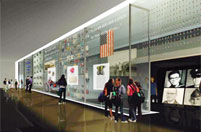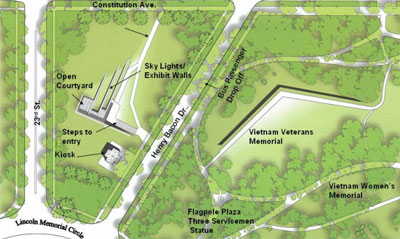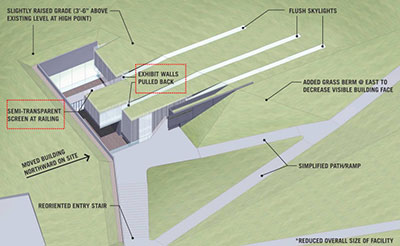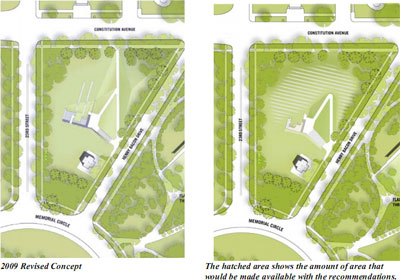Vietnam Visitors Center: How do you make a building invisible?
In 2003, amid much controversy, Congress authorized a new structure on the Mall, near the Vietnam Veterans Memorial: a visitors’ center to educate tourists about the Vietnam War and the meaning of the memorial.
Responding to the recent proliferation of new memorials and growing pressure for even more, the same act of Congress also placed a moratorium on any further construction in the Mall’s core, declaring the Mall a “competed civic work of art.”
To keep the visitors’ center from overshadowing the Vietnam Wall or other nearby memorials, Congress instructed that the building be underground, and gave the National Capital Planning Commission (NCPC) and Commission on Fine Arts (CFA) approval over the building.
During the subsequent years, NCPC, CFA, the National Park Service, and the veterans’ groups supporting the center have debated how exactly to build an underground building the size of a supermarket and make it virtually invisible from nearby streets.
NCPC authorized the building to occupy the grassy triangle northwest of the Vietnam Wall and northeast of the Lincoln Memorial, bounded by Constitution Avenue, 23rd Street, and Henry Bacon Drive. Currently, that triangle contains softball fields, a vending kiosk, and “passive” recreational space, and is surrounded by mature elm trees. To protect recreational users and the feel of the Mall, NCPC laid out a series of requirements, including:
- “The Visitor Center will be constructed underground as requried by the authorizing legislation for the project with no portion of the building and related building elements visible from any portion of the Lincon Memorial steps and podium, from Constitution Avenue, and from with in the axial view sheds of 23rd Street, NW and Henry Bacon Drive, NW.”
- “The Visitor Center will be designed such that light emanating from the Center’s interior will not be visible from any portion of the Lincoln Memorial, from Constitution Avenue, and from the Vietnam Veterans Memorial so as not to interfere with or encroach upon the Lincoln Memorial or the Vietnam Veterans Memorial.”
- “The Visitor Center will not intrude into the landscape. No protrusions such as skylights, monitors, light wells, or sunken areaways, will be visible from the sidewalk surrounding the site.”
- “The Visitor Center design will not impede the use of the site for multi-purpose recreation on the site.” NCPC also required NPS to replace any lost softball fields within a half mile of the site.
In December of 2007, the visitors’ center group presented a design. Visitors would walk down stairs or a ramp to a sunken entry area, then enter the building. Inside, they would proceeed back and forth along exhibit walls that are completely underground except for long, narrow skylights to illuminate the exhibits with natural light. The building also contained several sunken courtyards.
NCPC sent the design back for further work, as it didn’t comply with several of the requirements. From the Lincoln Memorial and Constitution Avenue, you could clearly see part of the building. NCPC also worried that, at night, light from inside the building would shine out from the skylights, making it especially visible.
Not all veterans support this project. At the December 2007 NCPC meeting, some veterans argued, as they had during the project’s initial debate, that the Vietnam Wall needs no “interpretation,” and a large explanatory center detracts from the artistic simplicity of the memorial itself. Mall advocates pointed out that if the Vietnam War needs an educational center, why not the Korean War, World War II, and on and on, which would completely overwhelm the Mall.
However, NCPC’s Presidential appointees pointed out that Congress had spoken clearly, and the law does not allow NCPC to reject the project entirely. Instead, they are trying to thread the needle by allowing a 31,000 square foot building while requiring it to be virtually invisible and have almost no impact on anyone.
At that meeting, members of the NCPC board (which combines Presidential appointees, representatives of federal executive agencies and Congress, and members from the District of Columbia) debated whether this was really possible. Some members, including Harriet Tregoning, suggested that NCPC consider a “pavilion” approach, allowing a small, visible above-ground building while placing the remainder truly underground. The rest of the board rejected that approach, however.
This week, NCPC will review a new submission. According to the staff report, the revised design has improved, but still fails to comply with the requirements of being completely invisible. The applicant has added a grass berm on the eastern side to screen the entrance from the Vietnam Wall, and moved it slightly to avoid the root area of the elm trees. They’ve also agreed to remove one of the three skylights. However, people will still be able to see the building from the Lincoln Memorial and from Constitution Avenue. Also, between the courtyards, ramps, and skylights, there’s very little space left for recreation on the site. According to the staff report, NPS has also still not responded to the requirement to replace the softball fields.
NCPC staff have a suggestion: remove the walkway from Constitution Avenue and the rest of the skylights, and shrink the open courtyard. Then, the building will be completely invisible from Constitution, and people can use more of the land for recreation.
The Board will debate the submission and the staff report on Thursday. If this meeting is anything like the last, it will have its share of fireworks and drama. And once NCPC, NPS, and the veterans backing the project finally design an invisible building, Congress should take this experience to heart and exercise uncommon restraint before authorizing any more underground museums.




